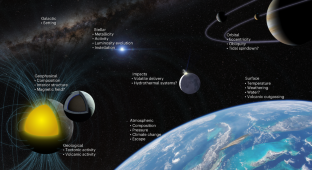2024-04-22 NASA
<関連情報>
- https://science.nasa.gov/solar-system/planets/mars/why-is-methane-seeping-on-mars-nasa-scientists-have-new-ideas/
- https://agupubs.onlinelibrary.wiley.com/doi/10.1029/2023JE007841
火星のような条件下での塩分を含んだ土壌シールの形成と安定性。火星のメタン変動への示唆 Formation and Stability of Salty Soil Seals in Mars-Like Conditions. Implications for Methane Variability on Mars
Alexander A. Pavlov, James Johnson, Raul Garcia-Sanchez, Ariel Siguelnitzky, Chris Johnson, Jeffrey Davis,…
Journal of Geophysical Research: Planets Published: 09 March 2024
DOI:https://doi.org/10.1029/2023JE007841

Abstract
Methane spikes observed in the Martian atmosphere require the abrupt release of large amounts of methane from the Martian subsurface. The mechanism for such release has not been identified. We tested whether gas traps can form under Mars-like conditions in the shallow Martian regolith due to salt migration in the icy soil. Experiments were performed on various soil samples in a Mars Simulation Chamber comprising different perchlorate salts and water concentrations mixed with JSC Mars-1A. Inside the chamber, the samples were exposed to a range of temperatures from −20°C to 10°C and maintained CO2 gaseous pressure between 8 and 10 mbars. As a methane analog, Neon was injected periodically underneath the soil sample. It was found that over a wide range of Mars-like soil parameters, a gas impermeable soil seal can form over a relatively short period (3–13 days) but requires 5%–10% of perchlorate salt content in the soil. It was determined that such a seal could sustain several mbars of neon above the Martian atmospheric pressure in the soil. Based on our experiments, substantial amounts of gaseous methane may accumulate under the soil seal and get released abruptly into the atmosphere upon seal cracking. An abrupt release of methane from the shallow subsurface may help explain methane variability at the Martian surface, as the Mars Science Laboratory detected.
Key Points
- Gas impermeable seals can form in Mars-like conditions in the soil with 5%–10% perchlorate salts by mass and a shallow permafrost layer
- Methane could accumulate under the seal in the shallow subsurface and be released abruptly into the atmosphere when the seal breaks
Plain Language Summary
Spikes of atmospheric methane on Mars, recently observed by the Mars Science Laboratory mission, are puzzling. To explain rapid variations in methane abundance in the Martian atmosphere, methane has to be released abruptly. Our experiments in the Mars simulation chamber demonstrated that perchlorate salts can be transported toward the surface regolith via water migration and subsequent sublimation. We showed that under Mars-like conditions, the soil with migrated salts can become cemented and form a solid gas impermeable seal. Methane and other volatiles can accumulate under the soil seal. Methane seasonal variability and occasional methane spikes in the Gale crater on Mars can be due to a sudden release of methane from the soil gas pockets when the Curiosity rover breaks soil seals by moving or drilling.



